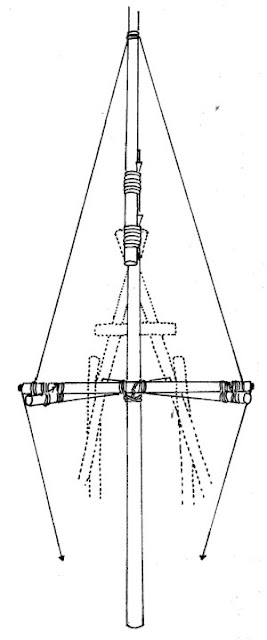Here's a report from page 200 of the 1951 Scout Annual - as far as
I've been able to discover, the first Scouting 'Kon-Tiki' event.
Here is the article in it's entirety, with text and photographs by Maurice Dybeck and sketches by John Sweet:
Brynbach Kon-Tiki
 |
Emerson Park full speed ahead in the race
|
HAVE
you ever slept in a floating tent? Deliberately, I mean. Not the sort
of tent that becomes water-borne halfway through a thunderstorm, but one
actually made to float? Inspired by the Kon-Tiki Expedition across the
Pacific on a raft, we decided to run our own little expedition on the
boating lake at Brynbach, the I.H.Q. camp site in North Wales. Somehow, a
couple of rafts would be built, launched, set adrift, and camped upon,
but as by no stretch of imagination could the lake be made to look like
the South Pacific, we built up a story about backwoodsmen escaping from a
forest fire. Here it is :
" You are a party of trappers
who have been traveling for many days through dense country. You have
just discovered that a forest fire will soon be upon you. Your only
hope of escape is to take to the water and remain there, as far as
possible from the bank, until the fire has passed (noon to-morrow). The
fire will reach you at 8 p.m. by which time you must be afloat—or
perish. " The natives (your own Troop) are friendly and may assist you
in the building of your raft, and you may borrow equipment, including
spars, cans, and rope from the Brynbach Trading Post. " You will of
course have to cook your supper and breakfast on the raft using an open
fire. You will also sleep on the raft. " In order to pass away the time
to morrow morning before the fire has passed, you will-1. Have a race
round the lake with the other trappers at 11.30. (Arrange this between
yourselves). 2 Fish for any items from the bottom of the pond
(especially tin cans). All booty to be brought ashore at 12 noon. 3 Make
a sketch survey of the lake including all items of interest. 4. If any
spare time left, think up and perform any other useful or interesting
activity. ' You must be able to swim. A log of your voyage must be kept
in proper nautical style. You must not touch land between 7 p.m. and 12
noon, and you must not receive any assistance after 7 p.m. The islands
in the centre of the lake are a blazing inferno throughout the voyage. "
If the raft capsizes or disintegrates, you must choose between drowning
and roasting. There is no alternative !"
The Troops which accepted the challenge were the 8th Crosby Sea Scouts from Liverpool and the 1st Emerson Park from Hornchurch, Essex.
 |
The start of the race with 8th Crosby in the lead
|
The
lake side at 3 p.m. on the great day was a wonderful sight. Oil drums,
tree trunks, corrugated iron, and even a tractor petrol tank had
appeared from nowhere and were piled ready for use. The judges strode
about with bits of paper in their hands, looking important. The sheep on
the hill-side paused in their grazing to stare with glassy eyes. The
competition was on. With quiet confidence the men of Emerson Park set
about building what looked for all the world like an enormous low altar
fireplace with knobs on. A number of five-gallon square oil drums were
lashed fore and aft, and the hole in the middle—sorry ! the 'tween
decks—was filled with a floor of Scout staffs big enough to take a hike
tent. To add dignity a mast was erected, rigged and flagged, and, using
this as one tent pole, a two-man hike tent was strung up facing for'ard.
The problem of making a fireplace on this highly inflammable structure
presented no difficulty to these intrepid backwoodsmen, who calmly laid
out a nice lawn at the front door of the tent. Armfuls of bracken were
taken aboard with the rest of the cargo, and with due ceremony the
mighty vessel was committed to the water. The Sea Scouts meanwhile had
been at work on a much lighter craft—built for speed, they declared. Two
rows of cans had been lashed to a light framework of spars, with one
large open-topped oil drum in the bow, the tractor tank in the stern,
and a corrugated iron superstructure. Being Sea Scouts they had scorned
the idea of a tent, and had rigged up a rakish looking tarpaulin shelter
such as the de-signers of Kon-Tiki would have rejoiced to see. The
finished craft had no mast and not much rigging, but it floated very
well—and that, as the crew pointed out, was the main thing. After the
launching the big oil drum, by accident or design, took on a gentle tilt
and looked every bit like a liner's funnel. Rumour spread that there
was an engine-room below, but in fact all the oil drum held was the
breakfast for the crew and the night's bedding. By eight that night,
punctual to the minute, the forest fire had enveloped the lake and both
parties of backwoodsmen had taken to the water and were safely anchored
in the middle. Loaded to the plimsoll as they were with bedding, cooking
pots, fire-wood and provender, yet they rode the waters bravely. The
Swiss Family Robinson could not have done better. Senior Scouts Geoffrey
Parker and Derek Tyler were the crew of the Emerson Park raft, and like
true men of Essex, despite the flaming forest around them their first
thoughts afloat turned to the cooking of supper. It was a pity, perhaps,
that the flames hadn't consumed the large crowd of spectators on the '
shore of the lake, who were extremely critical of everything they did.
How would you like to cook your supper on a floating lawn the size of a
pocket-handkerchief, practically surrounded by people whose only desire
was to see you sink or drop something overboard? But Geoff and Derek
bore up well and were enjoying a good supper with hot Oxo long before
the sun had set. On the Sea Scout raft, David Carylon and David
Pemberton, with but thirteen summers behind them, had youth on their
side, and being considerably lighter in weight were warm favourites for
the great race next day. Like all good Sea Scouts they decided to keep a
watch all-night—though I honestly don't know what they were watching
for. If a raft is going to sink in the middle of the night it will let
you know, whether you are awake or not..
 |
Side view of Emerson Park raft
|
 |
Plan of Emerson Park raft
|
By midnight, with no
greater mishap than a storm lantern overboard, they decided that all was
well and turned in. The moon came up over Bryn Ocyn and laid a silver
pathway across the lake where the two rafts rocked gently at anchor. An
owl hooted in the wood. Derek Tyler snored. Apart from that all was
peace. CAME the dawn, and to everyone's surprise the two rafts were
still afloat. The crews emerged from dreamland after what must have been
the strangest night of their lives. Breakfast, sketching and dredging
kept them busy until the time of the great race. And then an unexpected
complication arose. The Crosby craft, Robinson Crusoe, had apparently
developed engine trouble. Neither of the two Davids could persuade her
to move. Then, ten minutes before the race, when almost in despair, they
dis-covered the source of the trouble. They had forgotten to haul up
the anchor ! Quite a lot of the native tribesmen had survived the forest
fire and turned up in force to watch the race. Big Chief Panther
(Bailiff of Brynbach and one of the greatest living exponents of the art
of producing fire by friction) arrived with stop-watch and
starting-pistol. The long-suffering sheep on the hillside looked on with
pained expressions on their drawn faces . . . BANG They were off.
Almost at once Robinson Crusoe took a half-length lead over her
opponent, Queen Mary. At the halfway mark it looked like a walk-over.
Here the course narrowed and went sharply round an island. Robinson
Crusoe took the bend in grand style and started confidently on the
homeward beat. Then disaster overtook c her. A cable's-length from the
winning post she ran aground and no amount of punt-poling would
budge her. The Queen Mary bore slowly down upon them. Then, driven
desperate by the frantic yells and screams from their supporters on the
lakeside, the two Davids as one man jumped overboard, heaved the raft
bodily clear of the reeds, and scrambled aboard again just in time to
finish one length ahead of their rivals. Photographs, handshakes,
speeches, and dry land again brought their adventure to a glorious
conclusion. Sixteen hours afloat on their own raft ! The honours of the
race went to the Sea Scouts of the 8th Crosby but for the rest the men
of Emerson Park were declared the winners. A great race, and a great
adventure — everyone was happy.

So
ends the saga of the North Wales Kon-Tiki. But it may be that others
will wish to emulate this great adventure, so let me conclude with a few
tips from our own experience. Don't rely on wood alone for buoyancy.
This may be all right for a " mess-about ' raft, but is no use at all if
you want to keep dry. Use empty oil drums if you can get them—but do
test them for leaks before-hand (nothing is more unsettling than to hear
your raft going " glug-glug-glug " in the silent watches of the night
!) and don't put- them in sideways. Bung-holes don't matter if you have
them well above, or better still, believe it or not, right below
water-level. Once you know what materials are available, rough out a
plan in your note-book or on an odd piece of paper of the type of raft
you are going to build, and then set about the job in a workmanlike
manner. Finally, if you intend to cook your breakfast aboard, don't
forget to take some water !





















